B0041VYHGW EBOK (81 page)
Authors: David Bordwell,Kristin Thompson

Camera movements have held an appeal for filmmakers and audiences since the beginnings of cinema. Why? Visually, camera movements have several arresting effects. They often increase information about the space of the image. Objects become sharper and more vivid than in stationary framings. New objects or figures are usually revealed. Tracking shots and crane shots supply continually changing perspectives on passing objects as the frame shifts its orientation. Objects appear more solid and three-dimensional when the camera arcs (that is, tracks along a curved path) around them. Pan and tilt shots present space as continuous, both horizontally and vertically.
Moreover, it is difficult not to see camera movement as a substitute for
our
movement. The objects do not seem to swell or shrink. We seem to approach or retreat from them. We are not, of course, completely fooled. We never forget that we are watching a film in a theater. But camera movement provides several convincing cues for movement through space. Indeed, so powerful are these cues that filmmakers often make camera movements subjective—motivated narratively to represent the view through the eyes of a moving character. That is, camera movement can be a powerful cue that we are watching a point-of-view shot.
In commercial film production today, many camera movements are made with the camera on a dolly. Before the 1970s, it was standard practice to mount the dolly on rails for lengthy movements (hence the term
tracking
). (See
1.33
for a production shot showing an elaborate dolly shot.)
While mounting the camera on tracks is still done today, body-mounted camera units have become common as well. These devices allow the camera to be an extension of the operator’s normal walking or running. Servo mechanisms adjust for imbalances and jerkiness, so the camera seems to glide or float. The prototype of the body-worn camera stabilizer is the Steadicam, initially used on
Bound for Glory, Rocky,
and
The Shining.
A body-worn camera can go places that would be difficult for a dolly. The operator can smoothly follow actors climbing stairs, riding vehicles, and walking great distances
(
5.131
,
5.132
).
Some directors have taken advantage of the Steadicam to create lengthy shots moving through many locales, as in the opening scenes of Brian De Palma’s
Bonfire of the Vanities
and Paul Thomas Anderson’s
Boogie Nights.
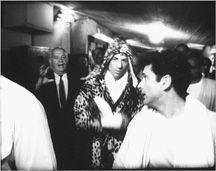
5.131 In Martin Scorsese’s
Raging Bull,
the Steadicam follows the protagonist out of his dressing room …
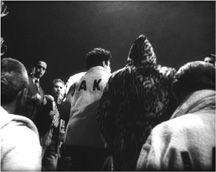
5.132 … and through a crowd up to the boxing ring.
Sometimes the filmmaker does not want smooth camera movements, preferring a bumpy, jiggling image. Commonly, this sort of image is achieved through use of the
handheld
camera. That is, the operator does not anchor the machine on a tripod or dolly, but instead uses his or her body to act as the support without benefit of compensating equipment
(
5.133
).
This sort of camera movement became common in the late 1950s, with the growth of the
cinéma vérité
documentary. One of the most famous early handheld traveling shots was in
Primary,
when a cameraman held the camera above his head and followed John F. Kennedy through a milling crowd
(
5.134
).
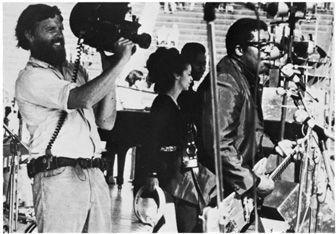
5.133 Don Pennebaker hand-holds the camera while filming his
Keep on Rocking.
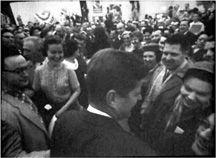
5.134 John Kennedy greeting a Wisconsin crowd in
Primary.
Handheld shots have appeared in many fiction films as well. Because the technique originated in documentary filming, it can lend an air of authenticity to pseudodocumentaries like
The Blair Witch Project.
In other instances, the handheld camera movement functions to create subjective point of view
(
5.135
).
Sometimes the handheld shot intensifies a sense of abrupt movement, as if the action were glimpsed on the fly. For
julien donkey-boy,
Harmony Korine used lightweight, bouncy, mini-DV cameras to shoot Julian shuffling through his neighborhood
(
5.136
).
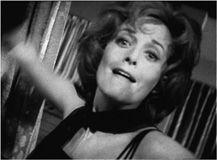
5.135 In Samuel Fuller’s
The Naked Kiss,
a handheld subjective camera heightens the impact of a fight.
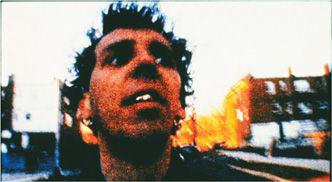
5.136 As Julien walks, the handheld camera’s jerky pace complements the explosions of color created by printing video up to 35mm.
A static camera can simulate frame mobility. In animation, the actual camera stays in one position, but by filming individual cels frame by frame, the animator can create the effect of camera movement
(
5.137
–
5.139
).
Alternatively, a mobile frame effect can be achieved by photographing a still picture or a stopped frame of film and gradually enlarging or reducing any portion of that image, as is frequently done in optical printing or with CGI. Iris masking can open up to reveal a vista or close down to isolate a detail.
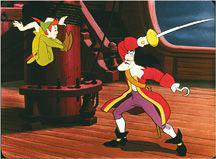
5.137 A pan shot simulated by animation in
Peter Pan
begins with Peter and Captain Hook near a mast. Peter swings in to kick Hook …
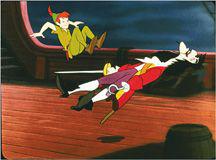
5.138 … and the framing pans to follow as the two fly rightward …
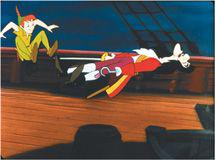
5.139 … across the deck.
